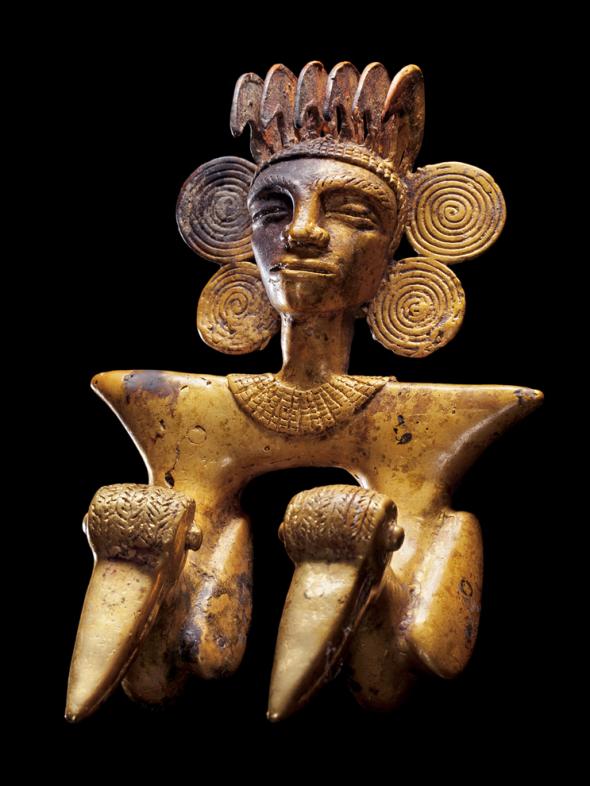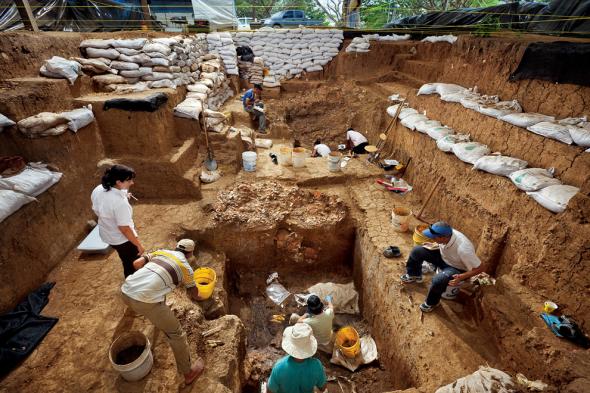By James Owen for National Geographic News | Published December 21, 2011.

Spectacular find” includes gold, jewels, and a small army of likely sacrifices. (Photograph by David Coventry, National Geographic).
New found tombs in Central America are yielding thousand-year-old gold, gems, and even hints of murder by pufferfish. But the real treasure is the excavation’s clues to the unnamed civilization of the so-called golden chiefs of Panama, archaeologists say.
“It’s really a very spectacular find. … probably the most significant” for this culture since the 1930s, when the nearby Sitio Conte site, also in central Panama, yielded a wealth of gold artifacts, anthropologist John Hoopes said.
Until now, Sitio Conte provided the only major evidence of the golden-chiefs culture, which can be traced from about A.D. 250 to the 16th century, when Spanish conquerors arrived on the scene.
Dating to between A.D. 700 and 1000, the new artifacts were excavated about two miles (three kilometers) from Sitio Conte, at a site called El Caño.

Striking Gold, Second Time Around
El Caño’s field of stone monoliths and sculptures had drawn treasure seekers in the early 20th century, but as luck would have it, they dug up only artifact-poor graves of common people.
A few years ago, after having worked at Sitio Conte—also marked by ancient monoliths—archaeologist Julia Mayo of the Smithsonian Tropical Research Institute decided to reinvestigate El Caño.
Mayo’s ground surveys, beginning in 2005, traced the circular outline of a series of burials, about 260 feet (80 meters) wide.
Not long after digging had begun, in 2008, the team uncovered the skeleton of a high-ranking chief, clad in circular breastplates embossed with ghoulish faces, patterned arm cuffs, and a belt of large golden beads—a taste of the bounty to come.
Stones, Bones, and Gold
The most recent dig, in early 2011, uncovered a similarly adorned chief in a multilevel burial pit once sheltered by a wooden roof. Surrounding this golden chief are at least 25 carefully arranged bodies, making the assemblage the largest of the six El Caño burials revealed to date, according to Mayo, who received funding from the Panamanian government as well as the National Geographic Society’s Committee for Research and Exploration and Expeditions Council. (The Society owns National Geographic News.)
Among the corpses golden attire for a child, possibly the chief’s son: tiny gold plates, bracelets, earrings, and a necklace of semiprecious stones.
At the bottom of the pit, the chief himself was supported by a sort of platform created from the tight arrangement of 15 bodies.
Mayo believes those individuals could be war captives or slaves who were sacrificed or committed suicide—a potential link to Sitio Conte, where similar burial arrangements have been found.
Murder by Pufferfish?
The team also uncovered a grisly clue as to how the apparent sacrifices might have met their fates, though forensic analysis is still underway.
“A vessel full of bones of a blowfish [pufferfish], Guentheridia formosa, was found near the bodies—it is a very poisonous fish,” added Mayo, who also serves as president of the El Caño Foundation.
In another curious detail, the bodies surrounding the chiefs were covered in pieces of ceramic plates. Though the plates’ significance is not yet clear, Mayo said they appear to have been made specifically to cover the corpses. The plates, she noted, are decorated only on what would normally be there undersides and were placed facedown on the bodies.
Hoopes, of the University of Kansas, noted similar ceramic finds at Sitio Conte.
“They would take the [plates] that were used during the feasts, which had been specially prepared, and they would place those in the graves,” said Hoopes, who wasn’t part of the El Caño excavations.
“What’s not clear is whether [the ceramics were] intentionally smashed or whether they were placed in the graves intact and broke over time due to shifting of the earth.”
Vampires, Werewolves, and Mascots
Among other El Caño mysteries are the half-human beings and mythological creatures in the designs of the gold jewelry and other burial finery.
“We are still working on the iconographic analysis,” project leader Mayo said. “According to some experts, these designs could represent the ancestors of clans or kinship groups.”
Hoopes said, “I think they’re analogous to werewolves and vampires in Western culture, in that you have fangs and transform into animals or part-animals.”
The idea of being represented by an animal spirit was widespread among pre-Columbian cultures of the Americas, he added.
A person might have had “a corresponding animal spirit that can inhabit them and change their personality and make them more effective in warfare”—not unlike the use of fierce mascots to inspire football teams, Hoopes said.
Who Were They?
Project leader Mayo hopes the treasure trove of material emerging from El Caño—including axes, packets of stingray spines, and a belt made of whale and jaguar teeth—can shed new light on the golden chiefs and their people.
The civilization, after all, left precious little historical record, at least that we know of.
“Part of the issue,” Kansas’s Hoopes said, “is that the devastation of the area by the Spanish happened so early and so completely that we still don’t know what language they spoke.”
He believes the Sitio Conte/El Caño people are “best regarded as a separate and distinct culture that flourished in central Panama.” But, he added, apparent trade items—including likely Colombian emeralds found at El Caño—suggest the culture had some connections to other groups.
Little remains of the golden chiefs’ built world either, hewn as it was from thatch and bamboo—in contrast to, say, the stony pyramids of the Maya.
Luckily the gold has proved more persistent, and more may await in up to 20 unexplored tombs at El Caño, according to Mayo—which gives Hoopes pause.
Despite the scope of Mayo’s discoveries, he said, “this is just a tiny part of an enormous complex. … It’s absolutely essential that sites like this are protected from looters.”
Read more at news.nationalgeographic.com.









